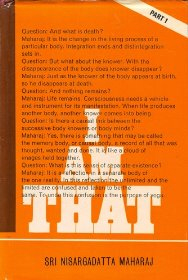6 Moksha
6-1 Preparation
6-2 Jnana, Jnani, and Jnana-Phala
6-2-5-3: 13(1 to 11) Arjuna asks Sri Krishna to explain six terms, namely, Prakriti, Purusha, Kshetra, Kshetrajna, Jnana, and Jneyam. They can be reduced to three. Prakriti and Kshetra are the same and represent the material universe. It is a field of experience. Purusha, Kshetrajna, and Jneyam are the same and represent the consciousness principle. Sri Krishna explains that the body is Kshetra and the knower of Kshetra is Kshetrajna. The physical body is like a field because karma requires a field for performance. In this sense, the mind and external world are also fields. Their common features are that they are made of matter and inert in themselves and further that they are subject to change and decay. A knower of Kshetra is Kshetrajna. The knower is the consciousness principle. Hence Kshetrajna is the consciousness principle.
Tag Archives: purusha
Advaita in the Vedas – Rig Veda 10.90.2
Alongside Rig Veda 1.164.46, 10.90.2, part of the famous Purusha Sukta, is one of the most succinct declarations of Advaita in the Vedas. It goes further than 1.164.46, as it gives a name to ‘what is one’ – Purusha (the Self). It says,
It is the Self who is all this – whatever has been and whatever is to be.
We could easily mistake this for a mantra from the Upanishads or another Advaita text, as it is perfectly in-line with their teachings. For this reason, it is unsurprising that it later appears in the Upanishads, in Shvetashvatara 3.15. Continue reading
Bhagavad Gita (Topic-wise) Part 2
3 Jagat 2(28), 7(4 to 7), 8(3,4,17 to 19), 9(7 to 10), 13(6,7,26), 14(3,4), 15(1 to 3)
3-1: 2(28)
Sri Krishna has talked about different facets of creation at various places in BG. Some are contextual. For example, when Arjuna does not want to fight to kill the enemies who are his relatives, Sri Krishna says in 2(28) that creation is cyclical and there is no death. At the end of one cycle, it becomes unmanifest, rests in Brahm in potential form, and is manifested in the next cycle due to the maya power of Brahm. This process continues. There is no beginning, there is no end. A jiva is a part of creation and undergoes a similar process. Death of a jiva is followed by rebirth and so on. A clear understanding of the cyclical nature of birth and death has a sobering effect on the prospect of death.
Word by Word Scriptures
From 2015 to 2017, I posted a series of ‘Notes on Tattvabodha’ (31 parts) by Dr. Vishnu Bapat. (Beginning at https://www.advaita.org.uk/discourses/bapat/bapat01.html.) These provided word by word translations of the Devanagari Sanskrit as well as an English commentary.
Dr. Bapat now has his own site at Vishnu Rao Bapat – Soulbliss where he has continued this practice and has similar translations of Bhagavad Gita, Atma Bodha, Dakshinamurti Stotram, Bhaja Govindam, Astavakra Gita, Amrita Bindu Upanishad and Devi Stotram.
Here, as an example, are two verses from the Bhagavad Gita.
Continue readingQ.475 Witness-Consciousness
Q: Can you help me to clear the following doubts?
- What part of the body is referred to as the mind?
- Why cannot the witness consciousness be a 5th part of the mind, Ego (changing subject), Emotion, Reasoning, Memory and the witness (unchanging subject)? In other words why cant the witness Atman be limited?
- Why cannot there be multiple witness consciousness or multiple Atman’s.
- Can each Mithya have different Satyam? To me it is quite a big jump to say Satyam of everything is one and the same. I can get that everything can be reduced to atoms and particles but beyond that it is difficult to conclude that there is one Satyam?
samAdhi (part 2)
Experience versus knowledge – a brief look at samAdhi (Part 2)
(Read Part1)

Here is the 364th verse of the vivekachUDAmaNi, as translated by Swami Ranganathananda, of Ramakrishna Math: “Reflection should be considered a hundred times superior to hearing, and meditation a hundred thousand times superior even to reflection, but the nirvikalpa samAdhi is infinite in its results.” The verse is referring to shravaNa, manana and nididhyAsana initially and, traditionally, this is the ‘complete set’, taking one all the way to realization and jIvanmukti. But here, it goes on to imply that nirvikalpa samAdhi is vastly superior. As Swami Ranganathananda puts it: “Our first hand experience of the non-dual reality is infinitely greater than meditation. They can’t be compared… no wise man would give up the infinite bliss of non-dual experience and revel in unsubstantial things like reading and thinking. Reading, thinking and meditation are nothing compared to the direct experience of the reality.”
But here, one has to ask the question: who is experiencing what? And, if it is an experience (i.e. in time), it has a beginning and necessarily an end also. How does this stack up with the idea that NS equates to Self-realization? Swami Satprakashananda even says later in the book that few seekers attain NS and even fewer return to ‘normal consciousness’ subsequently. “Their experience of NS is, as a rule, of short duration and hardly repeated. They leave the body in that state and attain Liberation (videha mukti). In exceptional cases the body stays alive in NS for twenty one days at the most, and then drops like a dry leaf.” Continue reading
Nisargadatta terminology
A frequent contributor to the site, Vijay Pargaonkar has provided the following valuable information rearding the terminology of Nisargadatta Maharaj:

When references to Nisargadatta Maharaj and his teachings come up at the AV forum during discussions, the arguments often seem to become tangential. I think this is mainly due to the differences in terminologies and definitions used by the followers of Nisragadatta and the ones used in traditional Advaita forums.
Last week I came across a rare Satsang tape in Marathi where Maharaj clearly lays out his version of the Creation Model and Prakriyas while explaining various Advaita terms according to his definitions. I have excerpts of this Satsang translation (as I heard and understood) below, where I have indicated the Sanskrit/Marathi terms along with the English terms used by the translator – the translator has actually chopped the live recording and inserted his English translation in between.
Creation Model
Prior to your waking is Nirguna, the substratum of Waking. The Nirguna is not at all bothered by this samara (samara = ‘war (of life)’). In Nirguna appeared knowledge (Bodha). This is pure Consciousness or Beingness or the Sense “I am” that has no shape or form. In this pure Consciousness there appeared a slight perturbation or movement and the pure Consciousness then grabbed a body-form (deharupa). After wearing this body form it started calling itself a man or woman while bound by different concepts (I am this; I am that; I am going; I am coming etc.). These concepts are all imaginary (Kalpana) and not real. Continue reading
‘ego’, self, and metaphysics – Part lV
In the Buddhist perspective, the ego or self as ordinarily considered in Western traditions (i.e., as soul or person), is a non-self, actually a non-entity (anatta). Hence the suffering, which stems from an experience -ultimately illusory- of separation and vulnerability.
Here we have to consider two things. First, according to Mahayana Buddhism, Adi-Buddha, equivalent to Dharmakaya – the highest metaphysical, or divine, level – represents that unique Being or Divine ‘State’, pervading all manifestation as Buddha-nature; and second, the notion of the Self (Atman, derived from the Hindu Vedanta) is not only compatible with that view, but also with that of the Spirit in Christianity and in Islam.
As to the soul (metaphysics and theology), though intrinsically perfect or whole in itself (one could add: in ‘primordial man’ –the purusha or Hiranyagarbha of Hinduism)- it experiences imperfection, self-limitation, anxiety and doubt in its state of (aparent) separation -the ‘fallen state’. Being, not just potentially, a ‘focal point of the Universe’, yet it becomes, through ignorance and self-will, the subject of illusions, attachments, and passions which lead to that predicament. Its condition is thus ambivalent; it can orient itself upwards (or towards the centre) – to ‘holiness’ and integration – or downwards, pulled by its ‘lower nature’ (nafs in its lower stages, according to Sufism). The end result will be either self-denial, or self-assertion; self-giving, or ego-centeredness. Inevitably, this latter tendency, based on ignorance, can only lead to an unwanted result: dispersal, disintegration, and suffering. Alas!, on the whole, if not in principle, psychiatry is not interested in this distinction or dichotomy; but let not anything else be said about this at this point.
From the viewpoint of advaita vedanta, all of what is described in this paragraph – and what follows – pertains to the empirical, relative (ontological and epistemological) level: mithya (or vyavahara), in other words. Continue reading
